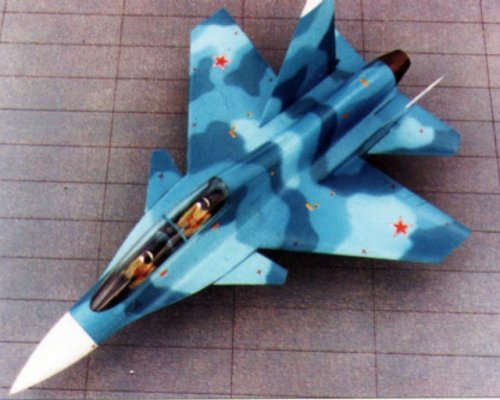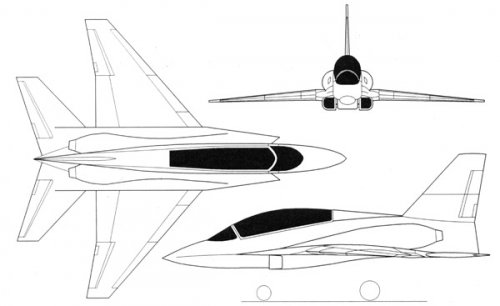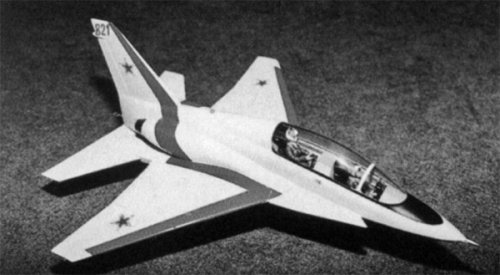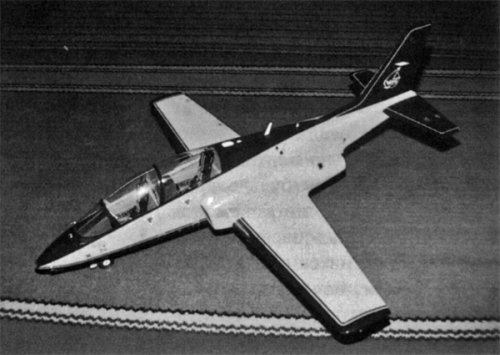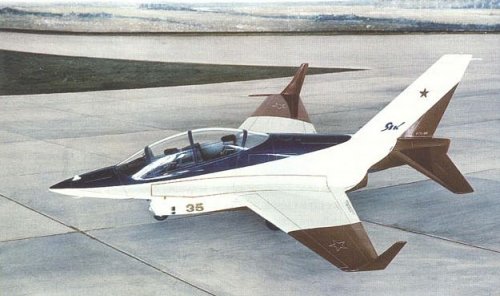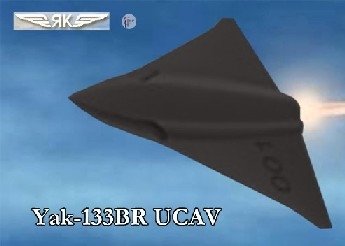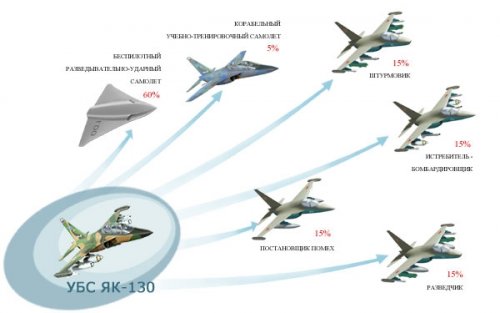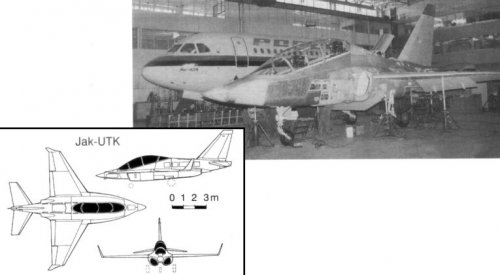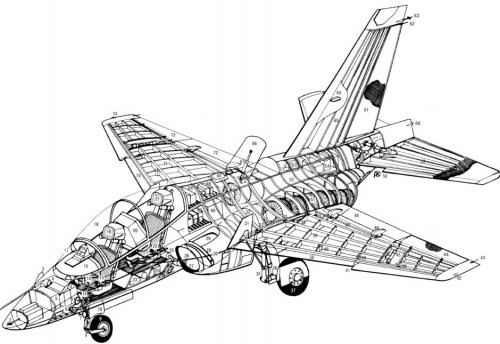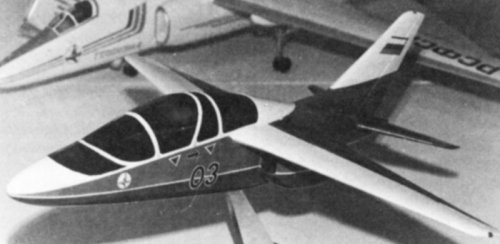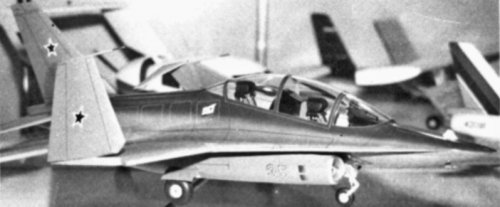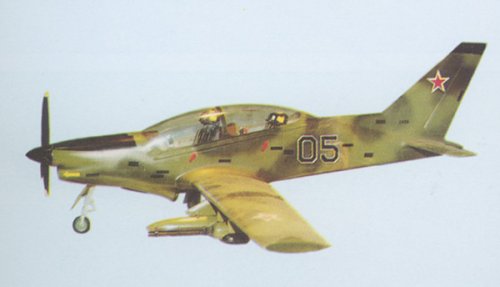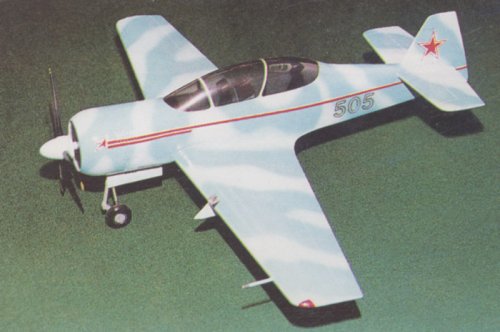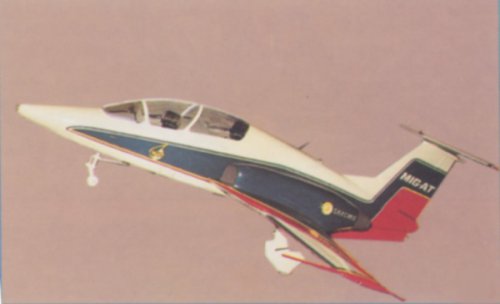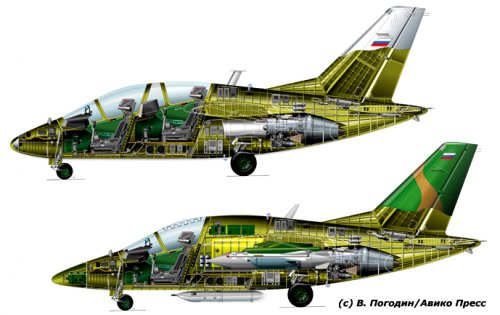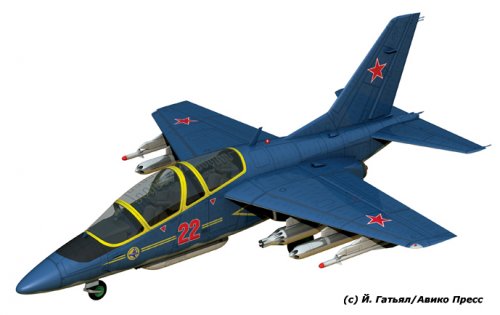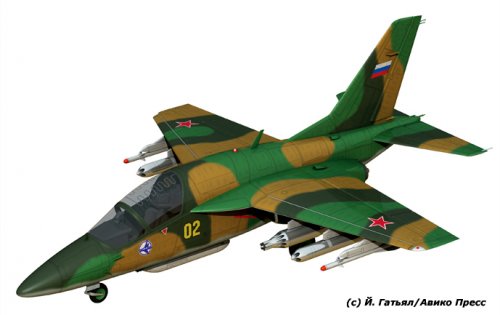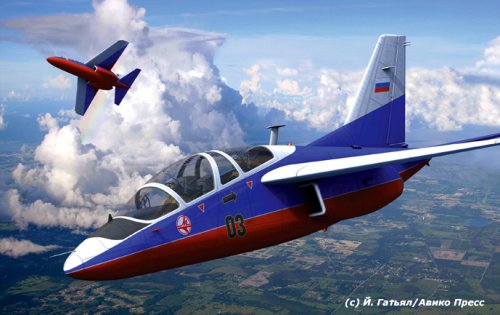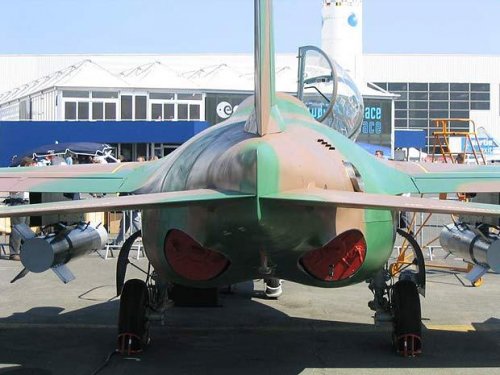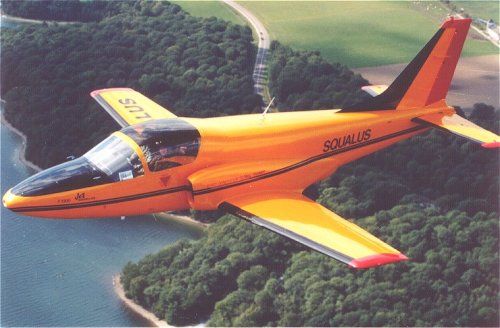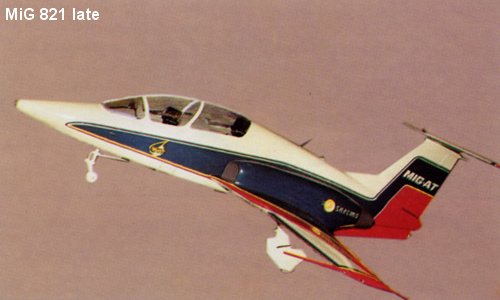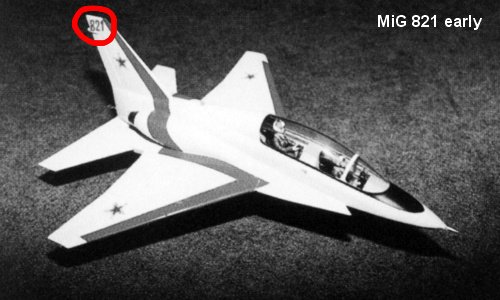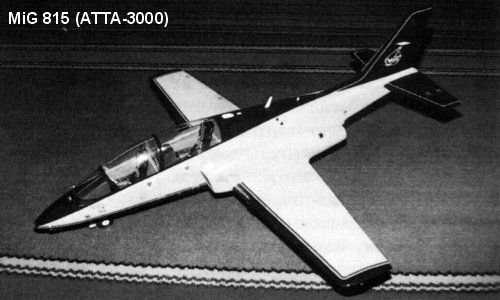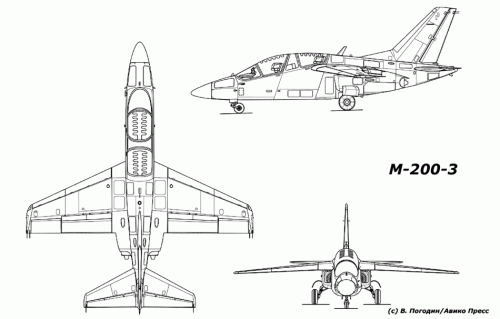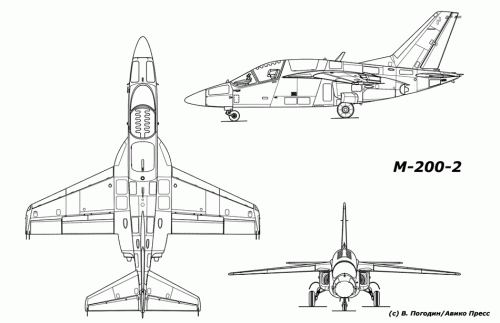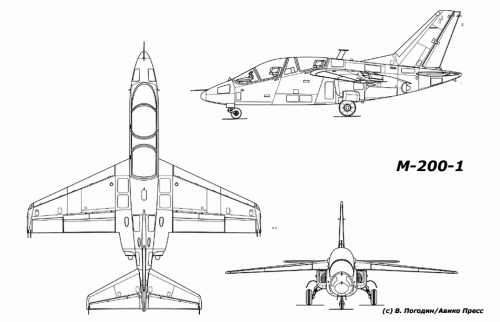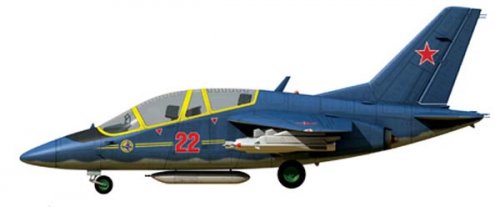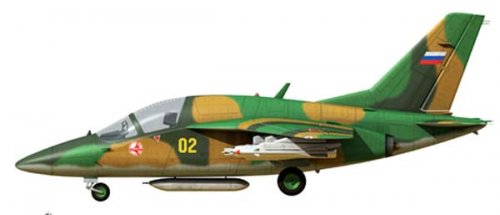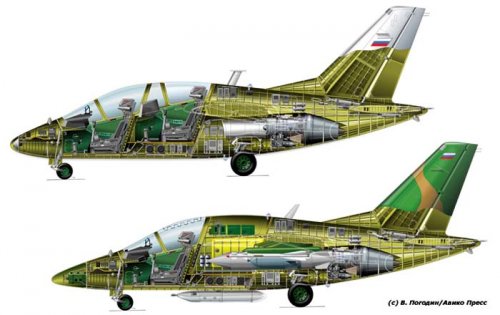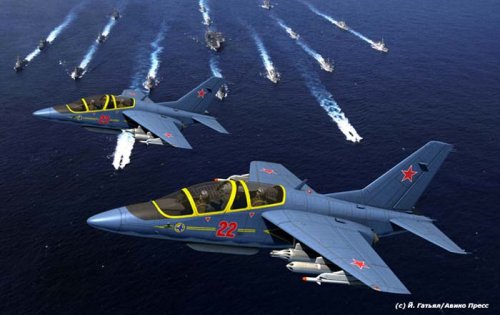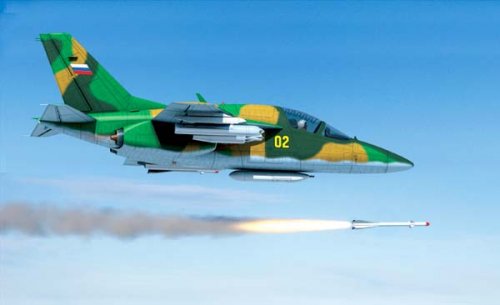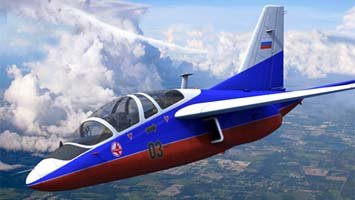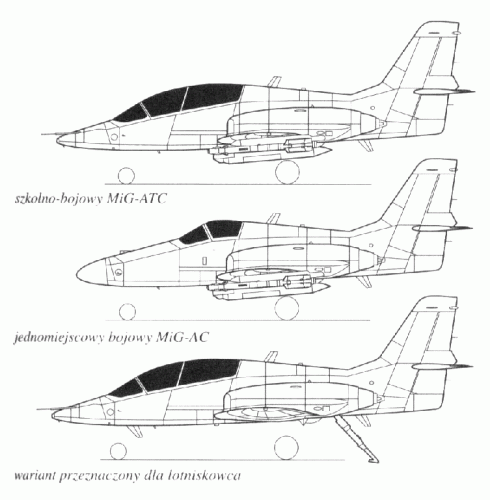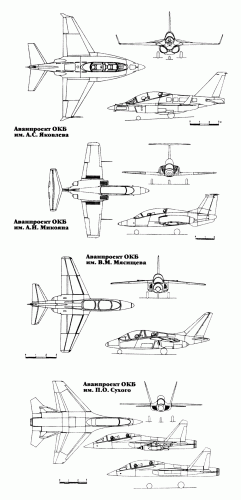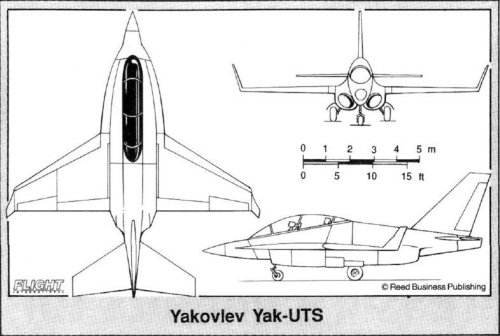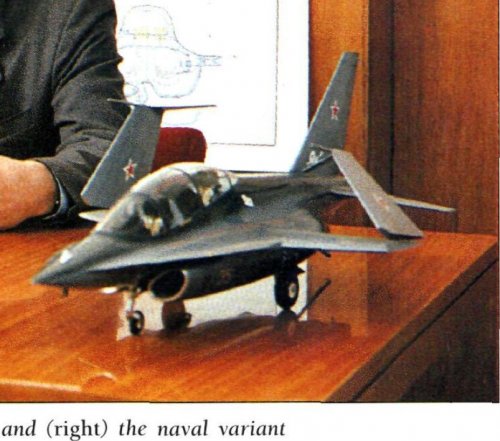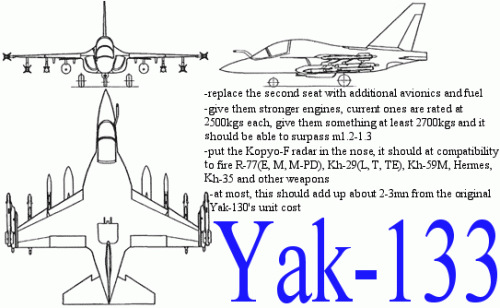You are using an out of date browser. It may not display this or other websites correctly.
You should upgrade or use an alternative browser.
You should upgrade or use an alternative browser.
UTS trainer competition: Yak-130, MiG-AT, Sukhoi S-54, Myasishchev M-200
- Thread starter Tuomasn
- Start date
Tuomasn
ACCESS: Secret
- Joined
- 5 January 2006
- Messages
- 477
- Reaction score
- 357
Myasishchev M-200 Master
Crew: 2
Wingspan: 9.40 m
Length: 10.37 m
Height: 4.20 m
Wheel base: 4.30 m
Wheel track: 2.70 m
Empty Weight: 3,805 kg
Normal TO Weight: 4,700 kg
Maximum Speed: 850 km/h at SL
Cruise Speed: 700 km/h
Take-off Speed: 180 km/h
Landing Speed: 155 km/h
Take-off Distance: 200 m
Landing Distance: 480 m
Ceiling: 13,100 m
Normal Range: 1,400 km
Ferry Range: 2,200 km
G-limits: +8/-3
Allowable AOA: 28-30 deg
Engines: Two Ivchenko R-35M turbofans of 16.67 kN each
The M-200 was developed for the UTS competition launched in January 1991. However, it was apparently judged worst of the four contenders in January 1992 when the first stage of the competition was summarized. Development has reportedly ended. The M-200 was to have a reprogrammable flight control system and automatic operation of wing control surfaces to enable simulation of various flight conditions with sufficient margin of stability. The M-200 together with the NUTK-200 ground system would have made the UTK-200 training system.
Sources
Crew: 2
Wingspan: 9.40 m
Length: 10.37 m
Height: 4.20 m
Wheel base: 4.30 m
Wheel track: 2.70 m
Empty Weight: 3,805 kg
Normal TO Weight: 4,700 kg
Maximum Speed: 850 km/h at SL
Cruise Speed: 700 km/h
Take-off Speed: 180 km/h
Landing Speed: 155 km/h
Take-off Distance: 200 m
Landing Distance: 480 m
Ceiling: 13,100 m
Normal Range: 1,400 km
Ferry Range: 2,200 km
G-limits: +8/-3
Allowable AOA: 28-30 deg
Engines: Two Ivchenko R-35M turbofans of 16.67 kN each
The M-200 was developed for the UTS competition launched in January 1991. However, it was apparently judged worst of the four contenders in January 1992 when the first stage of the competition was summarized. Development has reportedly ended. The M-200 was to have a reprogrammable flight control system and automatic operation of wing control surfaces to enable simulation of various flight conditions with sufficient margin of stability. The M-200 together with the NUTK-200 ground system would have made the UTK-200 training system.
Sources
- Brassey's World Aircraft & Systems Directory 1996/97
- Bill Gunston The Osprey Encyclopedia of Russian Aircraft, 1995
Attachments
Tuomasn
ACCESS: Secret
- Joined
- 5 January 2006
- Messages
- 477
- Reaction score
- 357
Sukhoi S-54
Crew: 2
Wingspan: 9.595 m
Length: 13.24 m
Height: 4.41 m
Wheel base: 3.45 m
Wheel track: 2.52 m
Empty Weight: 4,790 kg
Maximum TO Weight: 9,410 kg
Fuel Load: 1,660 kg
Maximum Speed: 1,650 km/h
Maximum Speed: 1,200 km/h at SL
Landing Speed: 170 km/h
Take-off Distance: 360 m
Landing Distance: 500 m
Ceiling: 18,000 m
Maximum Range: 2,000 km
G-limits: +9/-3
Engine: One Soyuz AL-31F turbofan of 74.53 kN dry
Armament: 6 x AAMs and ASMs, guided and unguided bombs and rockets
The S-54 was developed for the UTS competition launched in January 1991. Even though the official requirements called for a twin-engine aircraft, Sukhoi chose a single-engine layout due to lower operating costs. The S-54 has a fly-by-wire flight control system with programmable stability and switch-operated attitude and spin recovery. The crew sits on Zvezda K-36 ejection seats, and the aircraft features a glass cockpit similar to the Su-35. Radar is the N001 or N011. The S-54 was disqualified for having only one engine when the first stage of the UTS competition was summarized even though it featured the best performance parameters. Sukhoi then continued development on their own, leading to the S-55 with more emphasis on combat capabilities.
Attached picture is of the S-55.
Sources
Crew: 2
Wingspan: 9.595 m
Length: 13.24 m
Height: 4.41 m
Wheel base: 3.45 m
Wheel track: 2.52 m
Empty Weight: 4,790 kg
Maximum TO Weight: 9,410 kg
Fuel Load: 1,660 kg
Maximum Speed: 1,650 km/h
Maximum Speed: 1,200 km/h at SL
Landing Speed: 170 km/h
Take-off Distance: 360 m
Landing Distance: 500 m
Ceiling: 18,000 m
Maximum Range: 2,000 km
G-limits: +9/-3
Engine: One Soyuz AL-31F turbofan of 74.53 kN dry
Armament: 6 x AAMs and ASMs, guided and unguided bombs and rockets
The S-54 was developed for the UTS competition launched in January 1991. Even though the official requirements called for a twin-engine aircraft, Sukhoi chose a single-engine layout due to lower operating costs. The S-54 has a fly-by-wire flight control system with programmable stability and switch-operated attitude and spin recovery. The crew sits on Zvezda K-36 ejection seats, and the aircraft features a glass cockpit similar to the Su-35. Radar is the N001 or N011. The S-54 was disqualified for having only one engine when the first stage of the UTS competition was summarized even though it featured the best performance parameters. Sukhoi then continued development on their own, leading to the S-55 with more emphasis on combat capabilities.
Attached picture is of the S-55.
Sources
- Brassey's World Aircraft & Systems Directory 1996/1997
- Russian TV Star Air International October 1996
Attachments
- Joined
- 27 December 2005
- Messages
- 17,712
- Reaction score
- 26,170
- Joined
- 27 December 2005
- Messages
- 17,712
- Reaction score
- 26,170
The need for replacing the L-39 with a brand-new trainer was voiced by the Soviet Air Force's commander-in-chief, Air Marshal Yefimov, on 20 April 1990. In the summer 1990, the first official document was issued. It was the resolution by the State Military Industrial Commission, dated 25 June 1990 and tasking the Mikoyan design bureau with developing the future trainer.
Under the specifications requirements approved in October 1990, the advanced aircraft was to be powered by two engines as well as have a landing speed of within 170km/h (92kt), run and roll measuring 500m (1,640ft) at the most, unprepared airfield basing capability, a ferry range of 2,500km (l,350nm) and a thrust-to-weight ration of 0.6-0.7. In addition, the customer wanted the reprogrammable stability and controllability for the aircraft to be-fit for training pilots from all branches of the Air Force. The requirement for the trainer to be made of Russian parts only vas high on the customer's v-ish list. According to RusAF command's-estimates, at least 1,200 advanced trainers were necessary to oust the L-39 fleet. The first new trainers were to be received by users in 1994.
To reduce technical risk and obtain the best aircraft, the military called for a trainer aircraft competition among major Soviet aircraft developers. In January 1991, specifications requirements for a trainer for future tactical aircraft pilots were sent to MiG, Sukhoi, Yakovlev and Myasishchev. On 25 November 1991, Air Force CINC Col.-Gen. Pyotr Deynekin ordered a commission set up to review the conceptual designs submitted by the four bidders. The outcome of the tender was to be known on 15 January 1992.
Competition
Rather loose specifications requirements caused the bidders' different approaches to resolving the same problem. Each developer offered a concept of the complex as a whole and an aircraft in particular.
Prospective trainer specifications approved on March 1993
Flight performance Data
Normal take-off weight within 5,500 kg (12,000lb)
Thrust/weight ratio 0,6 - 0,7
Maximum speed at least 850 km/h (460kt)
Maximum Mach at least 0,8 - 0,85
Cervice ceiling over 10.000 m (32,00ft)
Minimum speed 210 - 220 km/h (113 - 119kt)
Range 1,200 km (650nm) ¥
Ferry range over 2,000 km (1,080nm)
Maximum angle of attack at least 25 degr.
Take-off speed, m 190 - 200 km/h (103 - 108kt)
Run within 500 m (1,640ft)
Roll within 700 m (2,300ft)
Sukhoi submitted the conceptual design of the S-54 aircraft - a single-engine derivative of the Su-27 fighter. It was to be powered by a single NPO Motor's R-195FS engine that was to be developed as an afterburning version of the production R-195 turbojet powering the Su-25 attack aircraft and producing supersonic speed of Mach 1.55. Unlike other contenders, the S-54 was intended for basic and advanced training. Sukhoi suggested the very concept of training on the 'common' aircraft be reconsidered. In the opinion of Sukhoi's design team, a combination of requirements for the initial, basic and advanced training capabilities in a single aircraft could be achieved at the expense of either safety or training quality.
Projects of alternative trainer aircraft for RuaAF tender, top to bottom - Sukhoi S-54, Myasishev M-200 and Mikoyan MIG-AT, 1992
A model of Yak-130 (then UTK-Yak), 1992
The Mikoyan design bureau strived to minimise the cost of the future trainer's development, which left its imprint on the style of its programme as a whole. Mikoyan submitted the conceptual design of the Aircraft 821 fitted with the straight wing and manual control system. The aircraft was designed 'around the engine': the Ivchenko-Progress AI-25TL was the only feasible option at the time. Special attention was paid to the plane's economic efficiency. Thus, while the annual training cycle on the L-39 called for 24.4t (53,7501b) of kerosene, Aircraft 821 could ensure a drop down to 20t (44,0001b) a year. The hope for developing the most efficient trainer was seen as a solid argument for Mikoyan's design dubbed later MiG-AT.
Myasishchev placed emphasis on technical training aids, offering its conceptual design of the UTK-200 trainer complex comprising the M-200 trainer aircraft and the complex's ground segment - NUTK-200. The latter included technical and flight crew training classrooms, simulators to train in general and special flight regimes, an integrated flight simulator with the moving cockpit and an air combat simulator with the fixed cockpit in a sphere. These were integrated through compatible software and the common supervision system. The M-200 trainer looked similar to the West European AlfaJet while featuring the reprogrammable control system. The M-200's powerplant was to include two future RD-35 engines had been under development at the Klimov plant.
The Yakovlev design bureau opted for an integrated development of the training complex designated as UTK-Yak. The complex comprised technical training aids (computer display classrooms, PC-based procedural simulators, functional simulators integrated through the use of common software) and the UTS-Yak aircraft later rechristened Yak-130. To enable the aircraft to fly at high angles of attack, it was to be fitted with a moderate-sweep wing featuring low aspect ratio and large leading-edge root extensions (LERX). Early in the development, the Yak-130 was to be powered by Ivchenko-Progress AI-25TL engines proven on the Yakovlev's Yak-40 passenger aircraft. Later, the AL-25TLs were to be replaced with a pair of Klimov RD-35s or Soyuz R120-300s. Close attention was paid to making the trainer's operation easier and self-sustained.
The Air Force commission faced the aggressive pressing of the contenders. Sukhoi's conceptual design earned the top aggregate points, but was rejected anyway. It failed to meet one of the specifications requirements as the single-engine design. Still, the commission's resolution submitted to the Air Force chief for approval stated, "The conceptual designs of the Sukhoi and Mikoyan design bureaux do not meet the specifications requirements", suggesting that "the development and mock-up manufacture of the UTK-Yak and UTK-2000 be continued". However, Mikoyan did not put up with the failure and insisted they should be allowed to carry on with their bidding.
In July 1992, the Air Force's scientific and technical committee summed up the outcome of the trainer conceptual design competition and took a decision worthy of Solomon: "The trainer's initial designing shall be conducted on the competitive basis by the Yakovlev design bureau in cooperation with the Myasishchev experimental plant and Mikoyan design bureau." However, the Air Force awarded only two contracts in late 1992 - one with Yakovlev and the other with Mikoyan. They were to submit their initial designs in the fourth quarter of 1993.
YAK-130: COMBAT TRAINER OF NEW CENTURY"
ВЗЛЕТ (TAKE-OFF) Magazine, June 2005
Posted on Yak website http://www.yak.ru/ENG/FIRM/art_switch.php?art=4
- Joined
- 27 December 2005
- Messages
- 17,712
- Reaction score
- 26,170
- Joined
- 12 July 2006
- Messages
- 947
- Reaction score
- 737
don't forget the Yak-131,Yak-133 and Yak-135 single and two seat trainers
and light attack version
I'm still waiting for illustrations of these three variants. Any idea where I can find them?
- Joined
- 12 July 2006
- Messages
- 947
- Reaction score
- 737
Thanks for all your help.
Tony Buttler mentions a Yakovlev Yak-135 in his Soviet Secret Fighters book (pg 61):
Where was it published? Can anybody post a scan of the photograph? Paralay? Flateric?
Tony Buttler mentions a Yakovlev Yak-135 in his Soviet Secret Fighters book (pg 61):
The existence of this light fighter was accidentally discovered in a photograph. In 1999 a Russian aeronautical magazine [Which one?] published a view showing Yakovlev OKB designers in discussion and behind them, on the wall, was a large poster showing an aircraft entitled ‘Yak-135 light tactical fighter’.
Where was it published? Can anybody post a scan of the photograph? Paralay? Flateric?
- Joined
- 26 May 2006
- Messages
- 34,819
- Reaction score
- 15,698
Sorry boxkite,
but there is no more explainations in the magazine,except they are
a single or two seat trainer/combat variants.and you know the Russian
companies used the same number twice or more .
all these Yak (131,133 and 135) are fitted with Saturn AL-55F engine.
but there is no more explainations in the magazine,except they are
a single or two seat trainer/combat variants.and you know the Russian
companies used the same number twice or more .
all these Yak (131,133 and 135) are fitted with Saturn AL-55F engine.
- Joined
- 1 April 2006
- Messages
- 11,364
- Reaction score
- 10,150
boxkite said:Thanks for all your help.
Tony Buttler mentions a Yakovlev Yak-135 in his Soviet Secret Fighters book (pg 61):
The existence of this light fighter was accidentally discovered in a photograph. In 1999 a Russian aeronautical magazine [Which one?] published a view showing Yakovlev OKB designers in discussion and behind them, on the wall, was a large poster showing an aircraft entitled Yak-135 light tactical fighter.
Where was it published? Can anybody post a scan of the photograph? Paralay? Flateric?
Nope, but don't expect something drastically different from Yak-130 externally.
Matej
Multiuniversal creator
- Joined
- 27 December 2005
- Messages
- 17,712
- Reaction score
- 26,170
Early Yak UTS specs:
Length: 12.4m
Height: 4.6m
Wingspan: 11.36m
32.5 deg leading edge sweep
Engines: 2 x AI-25TLM turbofan
Takeoff weight: 5,500kg
Sea level speed: 850km/h
Ferry range: 2500km with 1800kg internal fuel and 700kg fuel in a conformal ventral tank
G limits: +8g/-3g
Source:
Airscene Air International April 1992
Length: 12.4m
Height: 4.6m
Wingspan: 11.36m
32.5 deg leading edge sweep
Engines: 2 x AI-25TLM turbofan
Takeoff weight: 5,500kg
Sea level speed: 850km/h
Ferry range: 2500km with 1800kg internal fuel and 700kg fuel in a conformal ventral tank
G limits: +8g/-3g
Source:
Airscene Air International April 1992
- Joined
- 27 December 2005
- Messages
- 17,712
- Reaction score
- 26,170
- Joined
- 27 December 2005
- Messages
- 17,712
- Reaction score
- 26,170
- Joined
- 27 December 2005
- Messages
- 17,712
- Reaction score
- 26,170
- Joined
- 27 December 2005
- Messages
- 17,712
- Reaction score
- 26,170
Matej
Multiuniversal creator
Machdiamond
ACCESS: Secret
- Joined
- 15 January 2007
- Messages
- 325
- Reaction score
- 34
This is an old thread that I did not know about but for the record, in reply #5 from Paralay the projet 815 is the one labeled MiG-AT and vice-versa. And as far as I can remember, project 815 was never formally submitted for UTS like the Mig-AT but was rather focused on JPATS exclusively.
--Luc
--Luc
Matej
Multiuniversal creator
Not really. Project 815 was the initial configuration. The real MiG-AT evolved from the 821 configuration. The version for the JPATS was the joint design by Promavia, MiG and Boeing, derived from Promavia Jet Squalus and was called ATTA 3000. The ATTA 3000 preliminary design was made for Promavia by Gene Kerrigan, who worked previously at the advanced design group with Rockwell. Mikoyan Design Bureau then proceeded with detailed design. The ATTA 3000 was powered by two Williams FJ-44, avionics was Bendix King, fuel system Intertechnique, hydraulics Vickers, etc. Wind tunnel testing was performed at TsAGI, and metal started being cut when Boeing found out that the JPATS leaned heavily towards the lowest DOC, favoring single turboprops. And that stopped the program. Boeing had gathered significant political support for the entrance of MiG into the JPATS at that time.
The ATTA 3000 cancellation burned the last financial ressources of Promavia, who was pronounced bankrupt a few months later. There was also the single seat version for the air-to-surface attacks called ARA 3600, but it was never build even as the mockup (as far as I know). MiG did not cooperate on the ARA 3600.
I am currently writing the Hitechweb update about this.
The ATTA 3000 cancellation burned the last financial ressources of Promavia, who was pronounced bankrupt a few months later. There was also the single seat version for the air-to-surface attacks called ARA 3600, but it was never build even as the mockup (as far as I know). MiG did not cooperate on the ARA 3600.
I am currently writing the Hitechweb update about this.
Attachments
Machdiamond
ACCESS: Secret
- Joined
- 15 January 2007
- Messages
- 325
- Reaction score
- 34
Matej said:Not really. Project 815 was the initial configuration.
No it really wasn't, the 815 and the MiG-AT are completely different designs for different markets. You can trust me, I was there. ;D
--Luc
Matej
Multiuniversal creator
Okay, seems that you know more than I do. So can you write something more about it? I am interested.
Machdiamond
ACCESS: Secret
- Joined
- 15 January 2007
- Messages
- 325
- Reaction score
- 34
I could probably write something about it, but I prefer not to go further than I have written on my web site for now. :-X
Maybe when I write a book in 20 years or so...
--Luc
Maybe when I write a book in 20 years or so...
--Luc
Matej
Multiuniversal creator
I would be very thankfull if you can at least clear the difference between the 815 and 821.
Machdiamond
ACCESS: Secret
- Joined
- 15 January 2007
- Messages
- 325
- Reaction score
- 34
Ok.
815
- Designed by Promavia with Jet Squalus wing and tail and a new fuselage design, for the JPATS
- After preliminary design was done, an agreement was struck with MiG and design was transferred so they could do the detailed design (which they did). MiG did not change anything to the preliminary design.
- Conventional flight controls, benign flight characteristics for ab-initio training (near ab-initio actually, after screening in a light aircraft).
821
- Designed by MiG for UTS
- Fly-by-wire, more thrust
I would say the main difference in terms of design between the two aircraft is that the MiG-AT is a lot more "advanced" in terms of where it brings the pilot in its curriculum, which the primary reason for the fly-by-wire system. You go from MiG-AT to MiG-29/Su-27 there is no intermediate step.
On the other hand, after the JPATS training, you still need to go to a T-38 before hopping into an F-16.
That is what I mean by different designs and different markets, completely separate projects.
--Luc
815
- Designed by Promavia with Jet Squalus wing and tail and a new fuselage design, for the JPATS
- After preliminary design was done, an agreement was struck with MiG and design was transferred so they could do the detailed design (which they did). MiG did not change anything to the preliminary design.
- Conventional flight controls, benign flight characteristics for ab-initio training (near ab-initio actually, after screening in a light aircraft).
821
- Designed by MiG for UTS
- Fly-by-wire, more thrust
I would say the main difference in terms of design between the two aircraft is that the MiG-AT is a lot more "advanced" in terms of where it brings the pilot in its curriculum, which the primary reason for the fly-by-wire system. You go from MiG-AT to MiG-29/Su-27 there is no intermediate step.
On the other hand, after the JPATS training, you still need to go to a T-38 before hopping into an F-16.
That is what I mean by different designs and different markets, completely separate projects.
--Luc
Matej
Multiuniversal creator
Thanks, now I understood. We are both right, however I used the bad designations. By "815" I meant the thing derived from MiG izdeje 33 LFI, but it is apparently early "821" configuration. So the picture in reply #5 by Paralay is badly named. The correct designations should be as follows (right?):
Attachments
Machdiamond
ACCESS: Secret
- Joined
- 15 January 2007
- Messages
- 325
- Reaction score
- 34
Yes, that's it.
--Luc
--Luc
- Joined
- 26 May 2006
- Messages
- 34,819
- Reaction score
- 15,698
hesham said:Dear Overscan,
please don't forget the Yak-131,Yak-133 and Yak-135 single
and two seat trainers and light attack version.
Here is a small info about previous aircraft;
YAK-131 light attack version.
YAK-132 also light attack version.
YAK-133 light bomber recce version.
YAK-135 supersonic light attack aircraft.
http://www.militaryparitet.com/nomen/russia/avia/data/ic_nomenrussiaavia/52/
http://translate.google.com/translate?js=n&prev=_t&hl=ar&ie=UTF-8&layout=2&eotf=1&sl=ru&tl=en&u=http://www.militaryparitet.com/nomen/russia/avia/data/ic_nomenrussiaavia/52/
- Joined
- 25 June 2009
- Messages
- 14,730
- Reaction score
- 6,069
Here is what I have on the Myassishchev M-200 Master project. I hope I'm not duplicating something from elsewhere on the forum.
Attachments
- Joined
- 25 June 2009
- Messages
- 14,730
- Reaction score
- 6,069
- Joined
- 25 June 2009
- Messages
- 14,730
- Reaction score
- 6,069
All four UTS contenders as depicted in a 1997 issue of AviaMaster:
- Preliminary project of Yakovlev Design Bureau (Yak-130)
- Preliminary project of Mikoyan Design Bureau (MiG-AT)
- Preliminary project of Myasishchev Design Bureau (UTK-200)
- Preliminary project of Sukhoi Design Bureau (S-54)
Attachments
- Joined
- 26 May 2006
- Messages
- 34,819
- Reaction score
- 15,698
Hi,
here is anther early Yak-130 drawing,and a naval variant Model.
http://www.flightglobal.com/pdfarchive/view/1992/1992%20-%200456.html?search=yak%20UTS
http://www.flightglobal.com/pdfarchive/view/1992/1992%20-%201282.html?search=yak%20UTS
here is anther early Yak-130 drawing,and a naval variant Model.
http://www.flightglobal.com/pdfarchive/view/1992/1992%20-%200456.html?search=yak%20UTS
http://www.flightglobal.com/pdfarchive/view/1992/1992%20-%201282.html?search=yak%20UTS
Attachments
Similar threads
-
Sukhoi S-54/S-55/S-56 Design Progression
- Started by TinWing
- Replies: 30
-
MDP program - the Mikoyan Product 701
- Started by Tuomasn
- Replies: 30
-
-
Northrop´s Stealth Aircraft-Prototypes and Projects 1940-1950-War Secrets-Volume Five
- Started by Justo Miranda
- Replies: 2
-
US Army's 1990s Armored Systems Modernization (ASM) Program (FIFV, Block III Tank, Crusader)
- Started by RyanC
- Replies: 77


